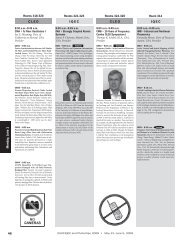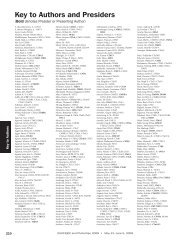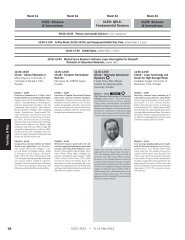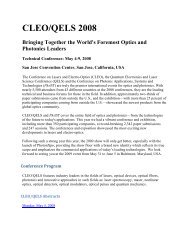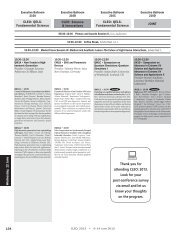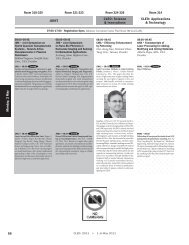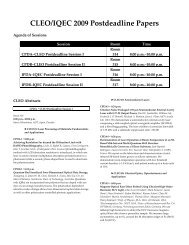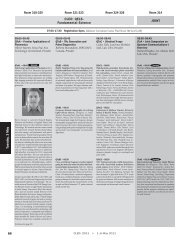CLEO: QELS-Fundamental Science Tuesday, 11 June
CLEO: QELS-Fundamental Science Tuesday, 11 June
CLEO: QELS-Fundamental Science Tuesday, 11 June
You also want an ePaper? Increase the reach of your titles
YUMPU automatically turns print PDFs into web optimized ePapers that Google loves.
Marriott San JoseSalon IIIMarriott San JoseSalon IVMarriott San JoseSalon V & VIMarriottWillow Glen I-III<strong>CLEO</strong>: Applications& Technology<strong>CLEO</strong>: <strong>Science</strong>& Innovations<strong>CLEO</strong>: <strong>QELS</strong>-<strong>Fundamental</strong> <strong>Science</strong>ATu3M • Symposium on ThePath to Sustainable Energy:Laser Driven Inertial FusionEnergy: Technology of ICF: DriveLasers, Optical and NuclearDiagnostics—ContinuedCTu3N • Imaging &Microscopy II—ContinuedCTu3O • Micro and Nano-scaleImaging Microscopy—ContinuedQTu3P • Symposium onNanophotonics at the DOE/SCNanoscale <strong>Science</strong> ResearchCenters: Nanoplasmonics—ContinuedCTu3N.3 • 17:15Measuring the 3D Position and Orientationof Single Molecules Simultaneously and Accuratelywith the Double Helix Microscope,Matthew D. Lew 1 , Mikael P. Backlund 1 , Adam S.Backer 1 , Steffen J. Sahl 1 , Ginni Grover 2 , AnuragAgrawal 2 , Rafael Piestun 2 , William E. Moerner 1 ;1Stanford University, USA; 2 University of Colorado,USA. Ignoring the anisotropic nature of singlefluorophoreemission in super-resolution microscopycan lead to large localization errors. Weuse the Double-Helix microscope to correct suchmislocalizations while simultaneously extracting3D position and molecular orientation.ATu3M.3 • 17:30 InvitedPlasma Refractometry Using Angular SpectralFilters on OMEGA EP, Dan Haberberger 1 , S.Ivancic 1 , M. Barczys 1 , R. Boni 1 , D. H. Froula 1 ;1Laboratory for Laser Energetics, USA. A fourthharmonic(263-nm) probe beam has been commissionedon OMEGA EP. A novel diagnostic hasbeen developed for it to diagnose plasma-densityprofiles using angular spectral filters to generatea contour map of refractive angles.CTu3N.4 • 17:30Depth-Resolved Nanoscopic Single ParticleTracking based on Fluorescence Phase-ShiftingInterferometry, Elad Arbel 1 , Alberto Bilenca 1,2 ;1Biomedical Engineering, Ben-Gurion Universityof the Negev, Israel; 2 Ilse Katz Institute forNanoscale <strong>Science</strong> and Technology, Ben-GurionUniversity of the Negev, Israel. We propose andanalyze fluorescence phase shifting interferometry(PSI) imaging for depth resolved single particletracking. Temporal PSI shows larger field of viewsthan that of spatial PSI, yet it attains lower depthlocalization precision.CTu3O.4 • 17:30 TutorialA Pragmatic Guide to Building a Multi PhotonMicroscope with Applications to Micro Machining,Jeffrey A. Squier 1 ; 1 Colorado School of Mines,USA. Construction of a multiphoton microscopefrom the excitation source, scan optics, excitationoptics, collection optics, and detection electronicsis described. A pragmatic, do-it-yourself approachis applied, resulting in the construction of a robustinexpensive platform.QTu3P.3 • 17:30 InvitedModeling, Fabrication, and Characterizationof Disk On-pillar Structures for Optical FieldEnhancement and Extreme Nanofocusing,Nickolay V. Lavrik 1 ; 1 Center for Nanophase Materials<strong>Science</strong>s, Oak Ridge National Laboratory,USA. Optimization of plasmonic disc on pillar(DOP) structures guided by FDTD simulations,their deterministic fabrication and characterizationby both Raman microscopy and dark-fieldspectroscopy are discussed. SERS enhancementfactors exceeding 10 9 are achieved using optimizedDOP structures.ATu3M.4 • 17:45Achieving full 1.8 MJ, 500 TW laser performanceon the National Ignition Facility, ShamasundarN. Dixit 1 , Jean-Michel Di Nicola 1 , Scott Burkhart 1 ,Paul Wegner 1 , Abdul Awwal 1 , C. V. Bennett 1 ,Mark Bowers 1 , M. R. Borden 1 , T. S. Budge 1 , J. A.Campbell 1 , L. Chang 1 , K. Christensen 1 , A. Conder 1 ,J. Chou 1 , G. Erbert 1 , Eyal Feigenbaum 1 , John E.Heebner 1 , M. Henesian 1 , M. R. Hermann 1 , V.Hernandez 1 , K. Jancaitis 1 , K. Lafortune 1 , R. Leach 1 ,R. Lowe-webb 1 , B. MacGowan 1 , K. McCandless 1 ,M. Nostrand 1 , C. Orth 1 , L. Pelz 1 , S. Pratuch 1 ,J. C. Palma 1 , M. Rever 1 , Richard A. Sacks 1 , T.Salmon 1 , Mike J. Shaw 1 , D. Smauley 1 , L. Smith 1 ,S. Sommer 1 , B. Van Wonterghem 1 , P. Whitman 1 ,K. Wilhelmsen 1 , J. N. Wong 1 , C. Widmayer 1 , S.Yang 1 ; 1 Lawrence Livermore National Laboratory,USA. We have achieved the NIF design goals forpower and energy by delivering 1.86 MJ of ultravioletenergy in a wide dynamic range (>300:1),22.5-ns shaped ignition pulse with a peak powerof 520 TW.CTu3N.5 • 17:45WithdrawnJeff A. Squier received the B.Sc. degree in EngineeringPhysics, and the M.Sc. degree in AppliedPhysics from the Colorado School of Mines,Golden,CO and the Ph.D. degree in Optics, in1992, from the University of Rochester,Rochester,NY. He was Research Faculty at the Center forUltrafast Optical <strong>Science</strong>, University of Michigan,and in 1995, joined the University of California,San Diego. Since 2002 he has been with the Departmentof Physics, Colorado School of Mines,Golden, CO. He established, and co-directs theCenter for Microintegrated Optics for AdvancedBioimaging and Control at CSM.<strong>Tuesday</strong>, <strong>11</strong> <strong>June</strong>ATu3M.5 • 18:00 InvitedOptical Probe Lasers for Characterizing Hightemperature,High-density Plasmas, SiegfriedGlenzer 1 ; 1 SLAC National Accelerator Laboratory,USA. In this talk we will present first Thomsonscattering results with unprecedented spectral,wavenumber and temporal resolution in shockcompressed matter and will discuss future experimentsaimed at measuring the physical propertiesof dense plasmas.CTu3N.6 • 18:00Single-cell photonic nanocavity probes, GaryShambat 1 , Sri Rajasekhar Kothapalli 1 , J. Provine 1 ,Tomas Sarmiento 1 , James S. Harris 1 , Sanjiv SamGambhir 1 , Jelena Vuckovic 1 ; 1 Stanford University,USA. We demonstrate for the first time high Qphotonic nanocavities operating inside singlebiological cells. We show in vitro protein detectionwith our tool as a route towards real-time label-freesensing in an intracellular environmentQTu3P.4 • 18:00 InvitedMaking Nanophotonics Devices a Reality:Nanofabrication of Advanced NanophotonicStructures, Stefano Cabrini 1 ; 1 Lawrence BerkeleyNational Laboratory, USA. To exploit the potentialitiesof Nanophotonics, it is important to controlthe properties of the material at the nanometerscale, obtaining a good agreement between theexperiments and the theory. Nanofabrication canopen the way for new concept of devices.Concurrent sessions are grouped across four pages. Please review all four pages for complete session information.1232013<strong>CLEO</strong> <strong>Tuesday</strong>.indd 325/17/13 3:<strong>11</strong> PM



